Key points
The Vitamin D Reference Laboratory utilizes a unique, highly accurate and precise reference method for total 25-hydroxyvitamin D (sum of 25-hydroxyvitamin D2 and 25-hydroxyvitamin D3) in serum. These reference method services are available to laboratories by request.

Vitamin D reference measurement procedures
CDC's reference method for total 25-hydroxyvitamin D uses high-performance liquid chromatography coupled with tandem mass spectrometry. It separately quantitates 25-hydroxyvitamin D2 and 25-hydroxyvitamin D3. The method has a high level of specificity and is not affected by other vitamin D isomers, such as C3-epi-25-hydroxyvitamin D3.
This reference method meets stringent analytical performance criteria (maximum allowable bias: ≤1.7%; maximum allowable imprecision: ±5%). This ensures that measurement results are highly certain and can be used to assess the measurement accuracy of clinical vitamin D tests.
The reference method is calibrated using certified reference material (SRM 2972a from the National Institute of Standards and Technology [NIST]). Therefore, measurement results obtained with this reference method are traceable to the International System of Units (SI), in accordance with the International Organization for Standardization (ISO) standard for traceability in laboratory medicine.
Keep in mind
More on reference laboratory for Vitamin D
What does the CDC's vitamin D reference method measure?
CDC's vitamin D reference method2 provides highly accurate measurements of total 25-hydroxyvitamin D (25-hydroxyvitamin D2 and 25-hydroxyvitamin D3). The Joint Committee for Traceability in Laboratory Medicine (JCTLM) database lists the method as a higher-order reference measurement procedure. As such, the reference method can be used to ascertain the accuracy of commercial assays and laboratory-developed tests.
What is certified reference material SRM 2972a?
SRM 2972a consists of two separate solutions of the vitamin D metabolites 25-hydroxyvitamin D2 and 25-hydroxyvitamin D3 in ethanol. It is intended primarily for use in calibration of instruments and techniques to test for these metabolites. These solutions are prepared with a high level of accuracy. The purity of 25-hydroxyvitamin D2 and 25-hydroxyvitamin D3 used to prepare these solutions is well defined. The manufacturing of the solutions is highly controlled to ensure consistency among vials and stability of the material.
What is traceability in laboratory medicine?
Traceability in laboratory medicine describes a process used to link a patient's results to a reference material or reference method. For vitamin D, SRM 2972a is used to calibrate a reference method. The reference method assigns reference values to serum samples. These serum samples are then used to calibrate a routine vitamin D test used to measure patient samples. In this process, measurement results for patient samples are traceable to SRM 2972a.
Establishing traceability in laboratory medicine is important because it defines the point of reference to which patient measurements are linked. This helps to ensure measurements in patient care are comparable.
Can CDC assign values to samples provided by my laboratory?
CDC works on meeting these requests, but such services are subject to availability of resources. For more information on reference measurement services, contact Standardization@cdc.gov.
- 2Mineva EM, Schleicher RL, Chaudhary-Webb M, Maw KL, Botelho JC, Vesper HW, Pfeiffer CM. 2015. A candidate reference measurement procedure for quantifying serum concentrations of 25-hydroxyvitamin D3 and 25-hydroxyvitamin D2 using isotope-dilution liquid chromatography–tandem mass spectrometry. Anal Bioanal Chem 407(19):5615 –24. A candidate reference measurement procedure for quantifying serum concentrations of 25-hydroxyvitamin D3 and 25-hydroxyvitamin D2 using isotope-dilution liquid chromatography-tandem mass spectrometry | Analytical and Bioanalytical Chemistry (springer.com)
